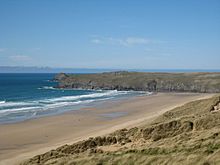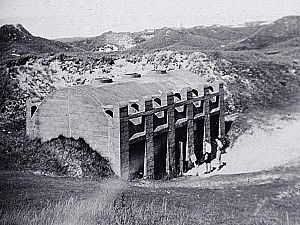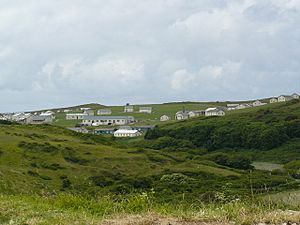Penhale Sands facts for kids
| Site of Special Scientific Interest | |

Dunes at Penhale Sands and Perran Beach
|
|
| Area of Search | Cornwall |
|---|---|
| Coordinates | 50°22′22″N 5°08′07″W / 50.3728°N 5.1353°W |
| Interest | Biological |
| Area | 1,070.4 hectares (10.7 km2; 4.13 sq mi) |
| Notification | 1953 |
Penhale Sands (in Cornish, Peran Treth, meaning St Piran's sands), also known as Penhale Dunes, is a large area of sand dunes on the north coast of Cornwall, England. It is a special place because of its amazing wildlife.
This area has the biggest sand dune system in all of Cornwall. People believe that Saint Piran, who brought Christianity to Cornwall, first landed here in the 6th century. His old church, St Piran's Oratory, is thought to be one of the oldest Christian sites in Britain. It was found in the late 1700s. In 2014, sand was carefully removed to show the church, which is over a thousand years old and still in good shape!
A military training area called Penhale Camp was set up here in 1939. It is in the northern part of the dunes. Penhale Dunes has been a Site of Special Scientific Interest (SSSI) since 1953. This means it is protected for its important nature. In 2004, it also became a Special Area of Conservation (SAC). The famous South West Coast Path walking trail goes right through these dunes.
Contents
Exploring Penhale Dunes Geography
Penhale Sands is about 5 miles (8.0 km) southwest of Newquay. It is part of the Perranzabuloe area. The dunes stretch for over 2.5 miles (4.0 km) between Perranporth in the south and Holywell to the north. The Atlantic Ocean and Perran Beach are to the west.
Experts believe the Cornish sand dunes started forming over 5,000 years ago. This was when sea levels rose to about where they are today. Penhale Sands is the largest dune system in Cornwall. The sand here can be as deep as 48 metres (157 ft)! This huge system covers over 650 hectares (1,600 acres). It reaches more than 1 mile (1.6 km) inland. It includes areas like Reen Sands, Gear Sands, and Perransands.
The South West Coast Path, a popular walking route, goes through these beautiful dunes.
A Look into Penhale Dunes History
The Story of Saint Piran
Many people believe that Saint Piran landed at Penhale Sands and Perran Beach in the 6th century. He came from Ireland and is known for bringing Christianity to Cornwall. He is now the patron saint of Cornwall.
Around that time, St Piran's Oratory was built in a hollow here. It is thought to be the oldest Christian site in Cornwall. It is also one of the oldest in all of Britain. The church was left empty in the 900s because sand started to cover it. A new church was built further inland, but it was also abandoned in 1795.
The site of the old oratory was dug up in 1835 and 1843. Then, in 1910, a large concrete structure was built around the remains. This concrete was removed in 1980. The delicate church was then buried in sand again to keep it safe. In 2014, the sand was removed once more. This showed the church's remains, which are still quite well preserved.
Penhale Camp Military History
Penhale Camp was set up in 1939. This was during World War II. Its purpose was to train soldiers to use anti-aircraft guns. You can still see signs of gun sites, searchlight batteries, and old defenses like pillboxes and trenches.
On June 7, 1940, a German bomber attacked the camp. It was probably looking for the nearby St Eval airfield. Twenty-two British soldiers died in this attack. Most of them were buried in nearby Perranporth. In 1943, the United States Army Corps of Engineers used the camp. They were getting ready for Operation Overlord, the D-Day landings. These engineers built the fourteen Nissen huts at the camp. These huts are still used today for training units.
In 1955, three soldiers drowned while swimming at Perran Corner. These waters are very dangerous with strong rip tides. At least two other people have also lost their lives here.
In April 2010, the Ministry of Defence closed the camp. It was sold in September of that year. However, the area is still under Ministry of Defence rules. Today, Penhale Camp is used for different military training. It is also used for adventurous activities like power kiting and coasteering. An adventure center called EBO Adventure Centre is now at Penhale Camp.
Penhale Dunes Protected Area
In 1953, the area was named the Perran Dunes Site of Special Scientific Interest (SSSI). Its name changed to Penhale Dunes in 1967 when it was made bigger. It is protected because it is a great example of a sand dune system. It also has many different plants, including four very rare types. In 2004, it was also named a Special Area of Conservation (SAC). The Penhale Dunes SSSI is next to the Kelsey Head SSSI to the north.
Wildlife and Ecology of the Dunes
The soil in the dunes has a lot of calcium carbonate. This comes from many seashell pieces. Because of this, plants that love lime grow here. These plants are usually rare in Cornwall. The area also has at least sixty-six types of moss. This makes it one of the richest places for moss in Cornwall.
Many rare plants have been found here. These include Babington's leek (Allium babingtonii), brackish water buttercup (Ranunculus baudotii), Cornish gentian (Gentianella anglica subsp. cornubiensis), and Portland spurge (Euphorbia portlandica). Because it is so important for lichens and rare plants, Plantlife has called the dunes an Important Plant Area.
The dunes are also very important for insects. Many Lepidoptera (butterflies and moths) live here. The silver-studded blue butterfly can sometimes be seen in thousands! Twenty-seven types of butterfly and one hundred and seven types of moth have been recorded in the dunes. The military area of Penhale Camp has helped protect nature here. This is because the public is not allowed in some parts.
Radio Receiver Station
Penhale Sands is home to a high frequency receiver station. This station is part of the Defence High Frequency Communications Service. The company Babcock International Group runs the station for the Ministry of Defence.
Penhale Dunes Folklore
The Legend of Langarroc
People say that Penhale Sands is where the legendary sunken town of Langarroc once stood. On stormy nights, some people claim they can still hear the bells of Langarroc's seven churches ringing from under the dunes.



